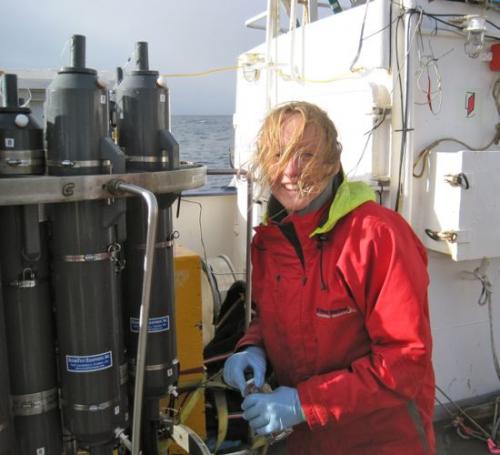It was easy to tell when we got out of the ice during the night. While in the ice, it's often tough to tell if the ship is even moving, and now that we're back in open water, we're rolling once again. As we head back to some of the stations that were cancelled at the beginning of the cruise, we'll only make a few short stops for grabs for the Russian benthic team and possibly the geology team. Jackie and others are anxious to go back to the earlier stations because they're areas of high productivity – "hot spots."
There are a few people on board who collect water from the CTDA research tool that is submerged in the water to measure conductivity (salinity), temperature, and depth. every time it comes on deck. One of those is Becky Garley, originally from Somerset, England, and now a research specialist at the Bermuda Institute for Ocean Sciences. She is a one-person team onboard, collecting CO2 samples for Dr. Nick Bates of the Bermuda Institute. Since she works alone, that means that Becky gets no relief from collecting water at every CTDA research tool that is submerged in the water to measure conductivity (salinity), temperature, and depth. cast throughout the cruise, 42 so far. She's always the first to collect water (to prevent loss of gas from the water) from each of the triggered bottles on every CTDA research tool that is submerged in the water to measure conductivity (salinity), temperature, and depth. cast, and she does it with rubber gloves to protect the samples from contamination. Because CO2 is a gas, it will off gas easily, particularly from the deeper bottles, because concentrations increase with depth due to pressure. Once she has her samples, Becky kills them quickly with mercuric chloride since any organisms in the sample would impact the dissolved inorganic carbon (CO2) count either by utilizing available CO2 (phytoplankton) or by producing it (animals). She´ll store her samples on board in a fairly constant temperature before bringing them back to Bermuda for DIC (dissolved inorganic carbon) and total alkalinity analysis. Scientists are particularly interested in areas we hope to reach on our cruise because the far northern Arctic Ocean is losing ice cover, and the water there is low in CO2. With ice loss comes additional exposure to the atmosphere, and the ocean might take up more of the CO2 and may become an additional carbon "sink." The study of DIC is important for many reasons, one of which has been recognized relatively recently. Ocean acidification results from the interaction of CO2 with the water, a reaction that produces a mild acid. With an increase in atmospheric CO2, scientists are concerned that a less alkaline and therefore increasingly acidic ocean could impact those organisms that depend on the DIC for processes such as shell production in mollusks and gastropods or the production of a calcium carbonate base for reef building corals. Using data collected from a number of areas for more than 25 years, scientists have shown that DIC has increased yearly due to increased concentrations of atmospheric CO2, and it´s important to continue to collect data and measure these changes.



Comments